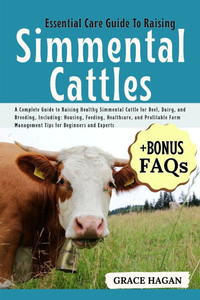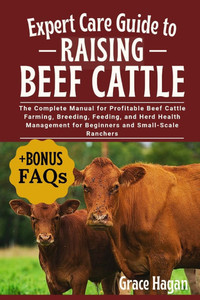
Expert Care Guide to Raising Cattle: The Complete Homesteader's Manual To Raising Healthy Beef And Dairy Cattles, Including: Feeding, Breeding, Housin
Independently published
ISBN13:
9798289277633
$19.14
Cattle raising is one of the oldest and most vital agricultural practices in the world. It plays a crucial role in food production, land management, and the global economy. Whether you're starting with a small herd or planning a large-scale operation, understanding the basics of cattle care, breed selection, and agricultural significance is essential for success.1. The Importance of Cattle in AgricultureCattle are central to many agricultural systems for several reasons: a. Meat and Dairy ProductionBeef cattle provide a major source of protein through meat. Dairy cattle produce milk, which is used to make a wide range of dairy products such as cheese, yogurt, and butter. The global demand for both beef and dairy remains strong, making cattle farming a viable and often profitable agricultural pursuit. b. Economic ContributionCattle farming supports rural economies by providing employment in breeding, veterinary services, feed supply, transportation, and meat processing industries. In many developing countries, cattle serve as a form of wealth, financial security, and social status. c. Byproducts and UtilityBeyond meat and milk, cattle provide valuable byproducts such as leather, gelatin, and manure. Manure is a rich fertilizer and is used in both traditional farming and biogas energy production. d. Land Management and Ecosystem BalanceGrazing cattle can help manage overgrown pastures, reduce wildfire risks, and promote biodiversity when managed properly. Cattle contribute to sustainable land use by converting non-arable land into food production through grazing. 2. Breeds and Their CharacteristicsCattle come in many breeds, each suited to specific climates, farming goals, and geographic conditions. Breeds can be grouped broadly into: a. Beef BreedsAngus: Known for high-quality marbled beef, early maturity, and ease of calving. Hereford: Hardy and adaptable with good temperament and beef yield. Charolais: Large-framed, fast-growing breed known for muscle mass and lean meat. Limousin: Excellent carcass quality with low-fat meat. b. Dairy BreedsHolstein: Most common dairy breed worldwide, known for the highest milk yield. Jersey: Smaller size, but produces milk rich in butterfat and protein. Guernsey: Known for golden-colored milk, high in beta-carotene and butterfat. Brown Swiss: Strong, adaptable cattle with high milk production and longevity. c. Dual-Purpose BreedsSimmental: Used for both milk and beef; large, productive, and docile. Shorthorn: Good for both meat and milk; known for maternal ability and fertility. d. Indigenous and Climate-Resilient BreedsBrahman: Excellent heat tolerance, disease resistance; ideal for hot, humid climates. Nguni (Africa) and Gir (India): Valued for hardiness, adaptability, and cultural significance in local systems.
- | Author: Grace Hagan
- | Publisher: Independently Published
- | Publication Date: Jun 23, 2025
- | Number of Pages: 00176 pages
- | Binding: Paperback or Softback
- | ISBN-10: NA
- | ISBN-13: 9798289277633
- Author:
- Grace Hagan
- Publisher:
- Independently Published
- Publication Date:
- Jun 23, 2025
- Number of pages:
- 00176 pages
- Binding:
- Paperback or Softback
- ISBN-10:
- NA
- ISBN-13:
- 9798289277633





